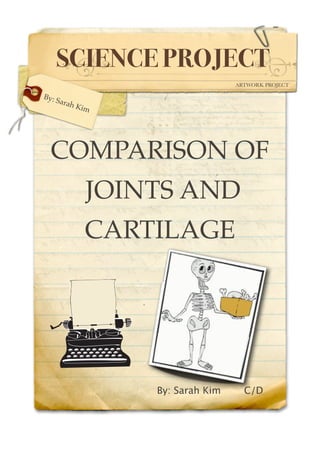
Comparison Of Joints And Cartilage
- 1. SCIENCE PROJECT ARTWORK PROJECT By: S arah Kim COMPARISON OF JOINTS AND CARTILAGE By: Sarah Kim C/D
- 2. COMPARISON OF JOINTS AND CARTILAGE Sarah Kim Science Project C/D Skeletal System Table of Contents BEGINNING Cartilage.......................................................................................1 Drawing of Cartilage..................................................................2 Joints.............................................................................................3 Drawing of Joints........................................................................4 Comparison of Cartilage and Joints.............................................................................................5 END
- 3. CARTILAGE ! PAGE 1 Cartilage is a thick layer of tissue with a smooth and slippery texture at the end of the bones. It is very flexible. Some examples of cartilage in your body are your ears, knees, elbows, ankle and nose. Without cartilage, the joints would not be connected and bones would rub each other. There has been misunderstandings and debates on whether cartilages contain blood vessels. However, it turned out that cartilage does not contain blood vessels or minerals. Nutrients are delivered to cartilage nearby the blood vessels. As shown in page two, the first picture, cartilage goes through a growing process. This represents cartilages of infant to an adult. When you are a baby, you only have cartilage in your body because the bones are forming. As you grow up, bones are replaced gradually. The third process takes place when bones are formed and when blood supply forms. Then, the bone takes place as you grow. The last cartilage in the picture shows when you are an adult. As you can see, there are very little cartilage and a marrow cavity. Osteoblasts, bone forming cells deposit calcium and phosphorus in bones, enabling bone tissues to be harder. Cartilage is essential in our body in many ways. First of all, cartilage is very important to joints because it can act as a shock absorber. Lastly, cartilage makes movement much easier. Without it, bones will rub against each other as they move and eventually they will worn out. People claim to experience the pain when cartilage is damaged. Some adults or elders complain that their bone is broken when their bones are rubbing together by lack of cartilage. Cartilage can damaged by disease, injury, or old age. Therefore, it is always a good idea to be healthy so your bones won’t be into serious damages!
- 4. JOINTS! PAGE3 Joints is where two or more bones are connected together. Joints are suppose to be far apart from cartilage so bones do not rub against each other as they move. Muscles move the bones by moving joints. There are two types of joints; Immovable and Movable Joints. Immovable Joints make little or no movement. In contrast, Movable Joints allows your body to make motions. Limited number of immovable joints are used in our body. Skull and pelvis are examples of the pivot joint, where joint allows no or very little movement. There are several types of movable joints and their uses; pivot, ball and socket, hinge, and gliding. Pivot Joint is when one bone rotates in a circle of another bone that doesn’t move. One example of this would be turning your head. A second type of joint is the Ball and Socket. It is a bone with a rounded end that fits to a cavity on another bone. These joints are used in your legs and your arms and those joints cannot swing in many directions. The third type of joint is the hinge. The hinge joint does a back and forth movement. For example; the elbow, knees, and fingers have hinge joints. It can not be dislocated easily or pulled apart like the ball and socket joint. Lastly, the forth joint is the gliding joint. It is one part of bone that slides over to another bone. Gliding Joint moves back and forth and they are usually found in your wrist, ankle and also between the vertebrae. Why do you think old people's back are hurt easily? It is because you need cartilage for protection. For elders, most of the cartilage are worn out. If you don’t have strong cartilage, joints are rubbed and you cannot move easily. Without joints, our body wouldn’t be in one piece, so it is important to maintain strong joints and cartilage!
- 5. COMPARISON OF JOINTS AND CARTILAGE! PAGE 5 As both cartilage and joints play essential part in our body structure and movement, they are both similar and different in many ways such as uses, shape and illness. Firstly, the uses of cartilage and joint has many differences and a few similarities. The differences of joints is that it connect bones and cartilage is a cushion that is like a shock absorber and helps your body move. The similarities is that it helps you do movement. Secondly, there are many differences and similarities of shape. Joints have four types of joints such as hinge, ball and socket, gliding, and pivot. All of these joints are fixed. Cartilage has no definite shape. The similarities of joint and cartilage is that, if a joint is shaped like a ball, then cartilage will be shaped around the ball. Lastly, illness can be easily damaged. Joints can be dislocated easily and rub each other often. If you make do movement alot, old age, lack of calcium or sport, cartilage is damaged. The similarities of joints and cartilage is that they both can be damaged by old age. There are more differences than similarities of joints and cartilage. However, both of them are essential in our body structure and movement. Without them, we could not do any work. Therefore, humans should try to be healthy by eating and exercising.